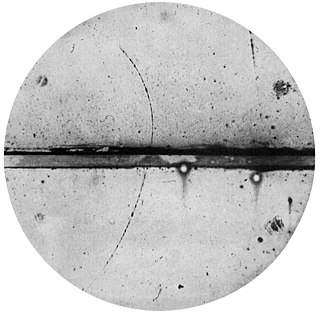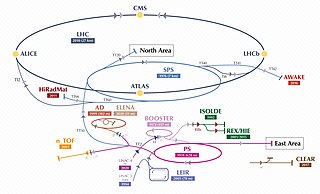
In modern physics, antimatter is defined as matter composed of the antiparticles of the corresponding particles in "ordinary" matter, and can be thought of as matter with reversed charge, parity, and time, known as CPT reversal. Antimatter occurs in natural processes like cosmic ray collisions and some types of radioactive decay, but only a tiny fraction of these have successfully been bound together in experiments to form antiatoms. Minuscule numbers of antiparticles can be generated at particle accelerators; however, total artificial production has been only a few nanograms. No macroscopic amount of antimatter has ever been assembled due to the extreme cost and difficulty of production and handling.

The positron or antielectron is the antiparticle or the antimatter counterpart of the electron. It has an electric charge of +1 e, a spin of 1/2, and the same mass as an electron. When a positron collides with an electron, annihilation occurs. If this collision occurs at low energies, it results in the production of two or more photons.

Antihydrogen is the antimatter counterpart of hydrogen. Whereas the common hydrogen atom is composed of an electron and proton, the antihydrogen atom is made up of a positron and antiproton. Scientists hope that studying antihydrogen may shed light on the question of why there is more matter than antimatter in the observable universe, known as the baryon asymmetry problem. Antihydrogen is produced artificially in particle accelerators.
Charge, parity, and time reversal symmetry is a fundamental symmetry of physical laws under the simultaneous transformations of charge conjugation (C), parity transformation (P), and time reversal (T). CPT is the only combination of C, P, and T that is observed to be an exact symmetry of nature at the fundamental level. The CPT theorem says that CPT symmetry holds for all physical phenomena, or more precisely, that any Lorentz invariant local quantum field theory with a Hermitian Hamiltonian must have CPT symmetry.
ATHENA, also known as the AD-1 experiment, was an antimatter research project at the Antiproton Decelerator at CERN, Geneva. In August 2002, it was the first experiment to produce 50,000 low-energy antihydrogen atoms, as reported in Nature. In 2005, ATHENA was disbanded and many of the former members of the research team worked on the subsequent ALPHA experiment.
This is a timeline of subatomic particle discoveries, including all particles thus far discovered which appear to be elementary given the best available evidence. It also includes the discovery of composite particles and antiparticles that were of particular historical importance.

MiniBooNE is a Cherenkov detector experiment at Fermilab designed to observe neutrino oscillations. A neutrino beam consisting primarily of muon neutrinos is directed at a detector filled with 800 tons of mineral oil and lined with 1,280 photomultiplier tubes. An excess of electron neutrino events in the detector would support the neutrino oscillation interpretation of the LSND result.

The gravitational interaction of antimatter with matter or antimatter has not been observed by physicists. While the consensus among physicists is that gravity is expected to attract both matter and antimatter at the same rate that matter attracts matter, this is not experimentally confirmed.
The PS210 experiment was the first experiment that led to the observation of antihydrogen atoms produced at the Low Energy Antiproton Ring (LEAR) at CERN in 1995. The antihydrogen atoms were produced in flight and moved at nearly the speed of light. They made unique electrical signals in detectors that destroyed them almost immediately after they formed by matter–antimatter annihilation.
Gerald Gabrielse is an American physicist. He is the Board of Trustees Professor of Physics and Director of the Center for Fundamental Physics at Northwestern University, and Emeritus George Vasmer Leverett Professor of Physics at Harvard University. He is primarily known for his experiments trapping and investigating antimatter, measuring the electron g-factor, and measuring the electron electric dipole moment. He has been described as "a leader in super-precise measurements of fundamental particles and the study of anti-matter."

The Antiproton Decelerator (AD) is a storage ring at the CERN laboratory near Geneva. It was built from the Antiproton Collector (AC) to be a successor to the Low Energy Antiproton Ring (LEAR) and started operation in the year 2000. Antiprotons are created by impinging a proton beam from the Proton Synchrotron on a metal target. The AD decelerates the resultant antiprotons to an energy of 5.3 MeV, which are then ejected to one of several connected experiments.

In particle physics, CP violation is a violation of CP-symmetry : the combination of C-symmetry and P-symmetry. CP-symmetry states that the laws of physics should be the same if a particle is interchanged with its antiparticle (C-symmetry) while its spatial coordinates are inverted. The discovery of CP violation in 1964 in the decays of neutral kaons resulted in the Nobel Prize in Physics in 1980 for its discoverers James Cronin and Val Fitch.
Standard-Model Extension (SME) is an effective field theory that contains the Standard Model, general relativity, and all possible operators that break Lorentz symmetry. Violations of this fundamental symmetry can be studied within this general framework. CPT violation implies the breaking of Lorentz symmetry, and the SME includes operators that both break and preserve CPT symmetry.
Lorentz-violating neutrino oscillation refers to the quantum phenomenon of neutrino oscillations described in a framework that allows the breakdown of Lorentz invariance. Today, neutrino oscillation or change of one type of neutrino into another is an experimentally verified fact; however, the details of the underlying theory responsible for these processes remain an open issue and an active field of study. The conventional model of neutrino oscillations assumes that neutrinos are massive, which provides a successful description of a wide variety of experiments; however, there are a few oscillation signals that cannot be accommodated within this model, which motivates the study of other descriptions. In a theory with Lorentz violation, neutrinos can oscillate with and without masses and many other novel effects described below appear. The generalization of the theory by incorporating Lorentz violation has shown to provide alternative scenarios to explain all the established experimental data through the construction of global models.

Hughes–Drever experiments are spectroscopic tests of the isotropy of mass and space. Although originally conceived of as a test of Mach's principle, they are now understood to be an important test of Lorentz invariance. As in Michelson–Morley experiments, the existence of a preferred frame of reference or other deviations from Lorentz invariance can be tested, which also affects the validity of the equivalence principle. Thus these experiments concern fundamental aspects of both special and general relativity. Unlike Michelson–Morley type experiments, Hughes–Drever experiments test the isotropy of the interactions of matter itself, that is, of protons, neutrons, and electrons. The accuracy achieved makes this kind of experiment one of the most accurate confirmations of relativity .

Modern searches for Lorentz violation are scientific studies that look for deviations from Lorentz invariance or symmetry, a set of fundamental frameworks that underpin modern science and fundamental physics in particular. These studies try to determine whether violations or exceptions might exist for well-known physical laws such as special relativity and CPT symmetry, as predicted by some variations of quantum gravity, string theory, and some alternatives to general relativity.
Searches for Lorentz violation involving photons provide one possible test of relativity. Examples range from modern versions of the classic Michelson–Morley experiment that utilize highly stable electromagnetic resonant cavities to searches for tiny deviations from c in the speed of light emitted by distant astrophysical sources. Due to the extreme distances involved, astrophysical studies have achieved sensitivities on the order of parts in 1038.

The Antihydrogen Laser Physics Apparatus (ALPHA), also known as AD-5, is an experiment at the Antiproton Decelerator at CERN, designed to trap neutral antihydrogen in a magnetic trap, and conduct experiments on them. The ultimate goal of this experiment is to test CPT symmetry through comparison of the atomic spectra of hydrogen and antihydrogen. The ALPHA collaboration consists of some former members of the ATHENA collaboration or AD-1 experiment, as well as a number of new members.
The rotating wall technique is a method used to compress a single-component plasma confined in an electromagnetic trap. It is one of many scientific and technological applications that rely on storing charged particles in vacuum. This technique has found extensive use in improving the quality of these traps and in tailoring of both positron and antiproton plasmas for a variety of end uses.

The Penning–Malmberg trap, named after Frans Penning and John Malmberg, is an electromagnetic device used to confine large numbers of charged particles of a single sign of charge. Much interest in Penning–Malmberg (PM) traps arises from the fact that if the density of particles is large and the temperature is low, the gas will become a single-component plasma. While confinement of electrically neutral plasmas is generally difficult, single-species plasmas can be confined for long times in PM traps. They are the method of choice to study a variety of plasma phenomena. They are also widely used to confine antiparticles such as positrons and antiprotons for use in studies of the properties of antimatter and interactions of antiparticles with matter.













